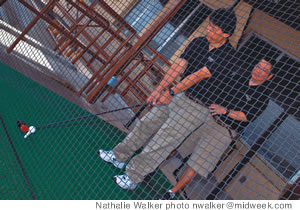
Helping Golfers Stay Healthy
September 15, 2010
By Glen Teramoto


Glen Teramoto, MSPT
Physical Therapist at REHAB
Where did you receive your schooling and training?
I received my undergraduate degree in economics from UH and did my master’s in physical therapy at the University of North Dakota.
How long have you been practicing?
I’ve been a PT for about 12 years.
{embed=“elements/box_ad”}
Can you tell me about the symptoms of golf injuries?
Golf demands that fine balance between mobility and stability, and at the moment of impact, it can cause compressive forces about eight times your body weight. A recent study found that among amateurs, the cause of injury is overuse, poor swing mechanics and/or striking the ground with the club. Proper spinal alignment is critical to proper swing mechanics, since according to the same study, the spine coils and uncoils 100-130 times in one direction over an average four-hour game. Because of golf’s asymmetry and multidirectional stresses, the movements are not the most natural for the body. With golfers, we often see a repetitive-type injury. Common areas of injuries are low back, elbows, hands, wrists and shoulders, all of which can get inflamed and become painful.

|
How do you treat someone with golf-related injuries?
We start by understanding the demands of the sport, so all of the therapists in this program are golfers. We know certain parts of the body are more susceptible to injuries, so we really look at how these parts of the body work together and because of weakness or tightness, the body will compensate to achieve the desired movement. This is often where injuries begin. Once the specific problems are identified, we work on educating the client on what parts of their body are weak and/or tight and how it can affect their golf swing, and we provide a home exercise program. We also have Pilates instructors here at REHAB, and they can work out specific exercises targeting core strength and stabilization as well as flexibility.
Have you seen much change in treatment over the years?
Yes, there’s a strong focus on core stabilization now, and a really powerful program is the Pilates method. With the golfer, it works to lengthen tight muscles, strengthen and realign core muscles to correct spinal imbalances, with attention on overall alignment and stabilization to promote better balance. Many of the PGA pros incorporate Pilates as part of their regular conditioning program. Also, with the availability of technology, the golfing community is more sophisticated in how it looks at performance and overall physical conditioning. There also is more awareness on things like proper warm-up stretches, maintaining hydration on the golf course and even proper skin protection.
What do you mean by “core stabilization”?
Core stabilization is about activating the deep truncal muscles to support the body through its many movements, especially those that generate force. Without the core strength to provide the stability through the pelvis and legs, balance is hard to achieve, and without proper balance or grounding, it’s hard to gain performance.
{embed=“elements/google_ad336x280”}
Is there a way to give preventative care?
As a physical therapist, we usually see folks after they’ve been injured. This is one of the main reasons we started the Back in the Swing! Golf Program. The best way is always prevention. Our goal is to educate golfers about their specific vulnerabilities and teach them how to strengthen specific muscles or stretch before they get hurt. Everyone’s body is different, and as we age our body changes depending on our medical history, so what works great for someone else may not always be good for you.
Can you tell us more about Back in the Swing!?
It’s a new program specifically to keep Hawaii’s golfers injury-free. The uniqueness in our program is we pair up a physical therapist with a golf instructor because we think the dynamic evaluation with the two together will give the most powerful results. Together, we look at how he/she stands and swings. They hit a few balls and we observe their posture, ability to move freely, the alignment of their body with the ball, etc. The physical therapist really focuses on how the body moves and what is restricted or weak, and the golf instructor looks at the sport-specific alignments and muscle coordination needed for performance. Each client leaves with a list of recommendations from both the golf instructor and the physical therapist. This program is especially good for folks who may have had some time off for surgery or an injury and are not quite sure if and when they are safe to go back to playing.
Do you have any tips to help people prevent golf injuries?
Stretching before you go out to the driving range or first tee is one of the easiest ways to prevent injuries. Even the pros get injuries, so it’s not always about the mechanics of your swing, it’s the nature of the powerful repetitive movement required in the game that can lead to injury.
Are there injuries that are chronic and can’t be fixed?
Our goal as physical therapist is not really to “fix” someone the way that a surgeon does. Instead, our goal is to really educate people about their bodies, where their specific vulnerabilities are for injury and give customized exercises that can correct these vulnerabilities. We work very closely with orthopedic surgeons and help patients take advantage of their surgical intervention for maximum results. As physical therapists, we have many tools to help the body heal and recover, including stretching and manually working the body tissue to help release tightness to using exercise techniques to retrain the body for improved balance, strength, coordination and agility. Everyone can improve. Even if you’ve had a complicated medical history, there are always things you can do to get your body more fit. In the end, it’s up to the golfer to do the exercises and incorporate the knowledge into their game.